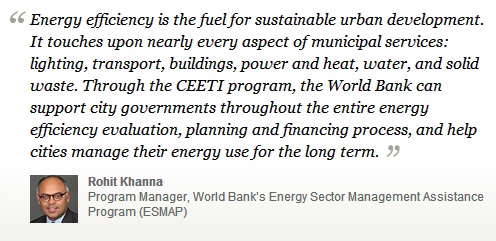
 A recent building boom in Nairobi reveals the challenges facing many fast-growing cities in developing countries. New buildings put up quickly were often highly energy-intensive. Municipal services struggled to keep up with energy demand. Between November 2012 and March 2013, at the request of the Kenyan government, the World Bank put together an energy profile of the metropolitan area. It showed that the city could make big savings by improving energy efficiency in buildings and the public water system.
A recent building boom in Nairobi reveals the challenges facing many fast-growing cities in developing countries. New buildings put up quickly were often highly energy-intensive. Municipal services struggled to keep up with energy demand. Between November 2012 and March 2013, at the request of the Kenyan government, the World Bank put together an energy profile of the metropolitan area. It showed that the city could make big savings by improving energy efficiency in buildings and the public water system.
The story is familiar: economic expansion, population pressures and tight budgets mean that services and infrastructure are often built out rapidly and haphazardly, locking cities into a resource-intensive cycle. Fortunately, a large part of the solution is also familiar, and well understood: energy efficiency.

“Energy efficiency is the fuel for sustainable urban development,” said Rohit Khanna, Program Manager for The World Bank’s Energy Sector Management Assistance Program (ESMAP). “It touches upon nearly every aspect of municipal services: lighting, transport, buildings, power and heat, water, and solid waste.”
The World Bank has worked with cities for years to conduct assessments of their energy use and to improve the performance of municipal sectors. A new initiative builds on this learning to help cities identify opportunities across sectors, and integrate energy efficiency into their strategic planning and operations.
The City Energy Efficiency Transformation Initiative (CEETI) will build the capacity of officials to develop energy efficiency plans and implement projects, help city governments develop prospectuses of promising efficiency investments, and match cities with sources of financing. In its initial three-year, US$9 million phase, the project will target up to 50 cities that have great potential for improved efficiency.
The overall goal is to harness energy efficiency to help cities realize cost savings and improve services while reducing local pollution and greenhouse gas (GHG) emissions. CEETI is an ESMAP-led effort in collaboration with the World Bank’s Information and Communication Technologies Unit (ICT) and the World Bank Institute (WBI).
“Through the CEETI program, the World Bank can support city governments throughout the entire energy efficiency evaluation, planning and financing process, and help cities manage their energy use for the long term,” said Khanna.
CEETI was announced in Barcelona on November 18 at CitiSense, a World Bank event on urban innovation targeted to senior municipal officials.
The first year of the program will support the integration of energy efficiency planning into decision-making, build the capacity of urban planners, promote learning and exchanges between cities, and facilitate partnerships with sources of public and private financing. The second and third years will provide dedicated technical assistance to cities to develop targeted energy efficiency investment programs, conduct pre-feasibility studies, and strengthen policies and institutions. At the same time, an innovation competition will offer incentives to technology developers to build applications that address ground-level challenges faced by developing country cities.
The new initiative builds on three years of World Bank engagement with cities on energy efficiency using the Tool for Rapid Assessment of City Energy, or TRACE, which has been deployed in 27 cities in Africa, Asia, Eastern Europe and Latin America. Developed by ESMAP, TRACE allows cities to quickly identify potential energy efficiency improvements, target underperforming sectors, and prioritize interventions.
“CEETI will have a significant capacity development component, because knowledge products, such as the course on ‘How to Use TRACE’, provide a well-established basis to further accelerate energy efficiency uptake in cities”, said Neeraj Prasad, Manager of the WBI Climate Change Practice.
In just one example, TRACE was used in Gaziantep, Turkey, to identify more than US$50 million in potential annual savings through measures including improvements at a municipal water plant, expansion of the public transportation network, and the retrofitting of municipal buildings.
ESMAP’s initiative is part of a broader World Bank effort to help cities plan and finance sustainable urban development, which also includes the Low Carbon and Livable Cities(LC2) initiative. LC2 offers a comprehensive package of support that targets climate-smart urban development, and can help cities tap their full emissions reduction potential.
Working together, these World Bank programs offer a full range of solutions for clients. For example, in the Rio de Janeiro, TRACE was used to identify two potential energy efficiency investments: efficient street lighting using LEDs and energy efficiency retrofits to municipal buildings, such as schools and hospitals. Going forward, CEETI will provide technical assistance for the implementation of the energy efficiency portfolio under Rio’s Low-Carbon City Development Program.
 View Map
View Map